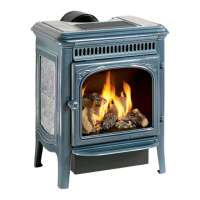9 Venting/Chimney Requirements
The draft hood is equipped with a safety shutoff
down draft sensor switch (spillswitch) which is
located in the draft hood just beneath the flue
collar on the rear of the unit. This switch is
designed to sense a loss of draft within the
chimney. The down draft sensor switch is wired
in series with the pilot thermocouple and is
typically in the closed position.
Should the Tucson fail to establish or lose draft
while in operation, hot exhaust gasses will spill into
the room through the bottom of the draft hood
instead of exiting the draft hood via the flue collar
and venting to the outdoors. When this undesirable
down draft condition occurs the hot gasses spilling
out of the draft hood will heat the spill switch
causing it to open which turns the unit off.
Do not modify, disconnect or otherwise defeat the
purpose of the down draft sensor switch. If your
stove shuts off during normal operation, it is
indicative of an unsafe venting condition which
must be corrected. Operation of this unit when
not properly connected to a properly installed and
maintained venting system or tampering with the
vent safety shutoff system can result in carbon
monoxide (CO) poisoning and possible death.
Power Venting
For applications where it is impractical or
impossible to exit B-1 vent pipe to above the
existing roof line, the Tucson can be vented
using a power vent. A power vent is
essentially
a specialized electric fan mounted on the outer
wall of the building which is connected to the
heater via the flue pipe. When the thermostat
calls for heat, the power vent turns on and
creates a draft in the flue pipe similar to the
draft
created by a properly functioning conventional
chimney. The Tucson operates in a normal
fashion, satisfied by the simulated draft. A
series of interlocking safety devices prevents
operation of the heater unless the power vent
is operating properly. Both the Tucson and
the power vent are controlled by the wall
thermostat and neither will operate if there is a
power failure. For installations requiring
power venting, use only an AGA (U.S.) Or
CGA (CANADA) listed unit. The power vent
supplier will in turn supply the power vent
installations.

